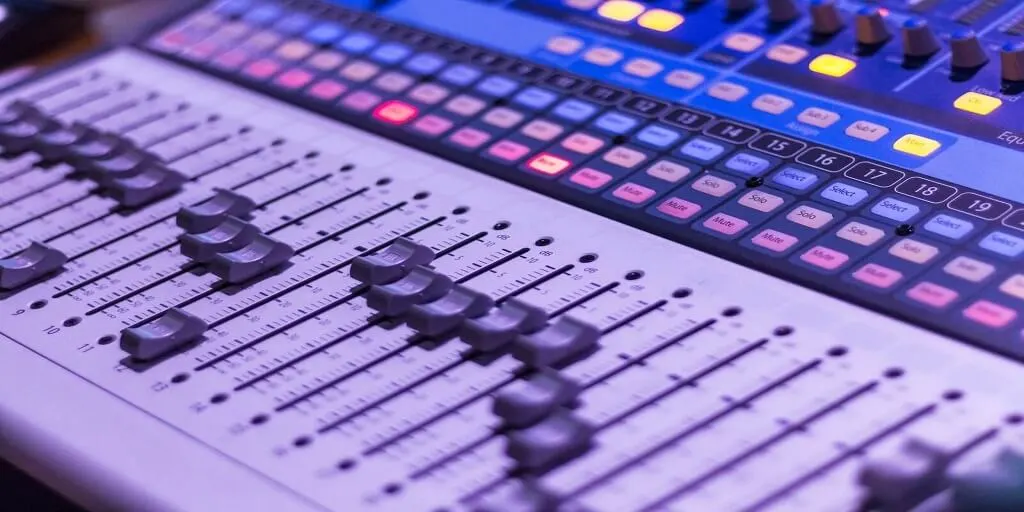Have you often thought about the best equalizer settings? After spending many hours on your favorite music player’s audio parameters, we have explored how they operate, regardless of the loudspeakers you use.
This guide will give you the knowledge you need to identify the optimal configuration for specific speaker systems and musical tastes. Since contrary to popular belief, there is no one optimal equalization setting that works for everyone.
Your auditory ability, the strength of the equipment, and the music you’re enjoying all factor towards determining the optimal settings.
Join us, and we will look into the optimal EQ levels for various musical styles and equipment!
A brief introduction to Equalizer
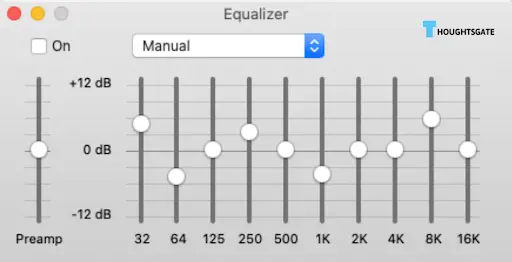
An equalizer is a device that can mitigate the effect of frequency differences. You can adjust the volume by turning up or down the frequency range. This adjustment will appear much more transparent with an illustration.
So, generally speaking, there are three distinct frequency ranges included in musical compositions. Bass consists of a wide range of low frequencies. The midrange and treble are also there.
You can make your music sound frequency by using equalization to raise the bottom end. It does not change the quality or integrity of the underlying audio file. When connected to headphones, it just amplifies the sound.
An equalizer is a tool that lets you adjust how loud particular frequencies are in a recording. Also, everyone should know how to change the volume. Once you learn how to use it, doors to untold sonic pleasures will open before you.
Once you learn how to utilize an equalizer properly, you will be able to enjoy your music to its fullest. Some songs sound better with more bass, whereas others with more clarity. If you’re familiar with how equalizers work, you can customize your listening experience to audio just right, regardless of the audio you play.
An Explanation of the Equalizer’s Working Mechanism
Using an equalizer, though, is surprisingly simple. Consider that practically any modern audio device includes equalization. In addition, modern audio devices come equipped with a digital equalizer that lets you adjust the frequencies you like.
Equalizers require a preliminary frequency scan before they can be put to use. Equalizers also vary in the level of digits they assign to frequencies. Graphic equalizers are another option for fine-tuning the sound’s frequency balance. You can achieve the finest potential sound by focusing on just a few primary frequency ranges.
BEST EQUALIZER SETTINGS
Best equalizer settings for bass
It can be challenging to discover an EQ setting that provides a bass-heavy audio sound that is clear and distinct from the rest of the mix. Below, we’ve detailed the best equalizer settings, including the best EQ settings for bass.
The low-frequency bass range lies from 20 Hz to 200 Hz.
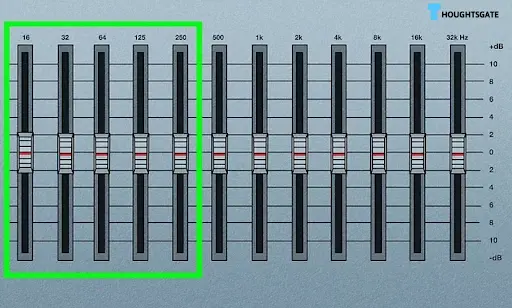
Hertz (Hz) is the standard frequency measurement unit for music frequencies and is integrated into all equalizers. There is a corresponding frequency for every single musical tone. Increase the dB levels in the 20 Hz-200 Hz area of the equalization to get the most out of the bass-heavy song.
In hip-hop, the bass frequency typically begins at 60 Hz.
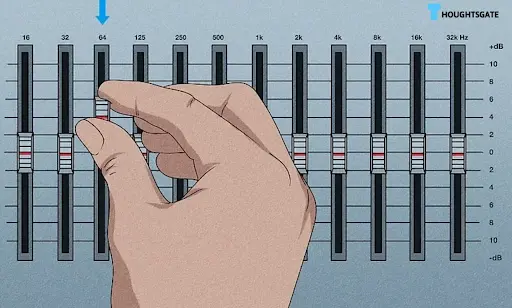
Amplifying the dB by approximately 60Hz over the EQ can help you enjoy the best from your favorite hip-hop songs and inspire you to make your rhythms. Melody pad basses usually sit here, together with kick beats and bassline chords.
Low-frequency content below 50Hz can get muddy without a good sound system. Therefore you should eliminate or at least tone it down. Sound effects and music in science fiction and action movies frequently use the low-frequency range known as “sub-bass.”
Instruments such as pianos and violins have a frequency around 200 Hz.
You can achieve deeper registers on string instruments like the electric guitar, piano, and others by increasing the dB at the upper end of the bottom bandwidth. Intensifying the dB inside the 200Hz region helps boost the volume of even bass-heavy elements like brass bands and vocalists.
- Make sure to try out a variety of various options within this range. To minimize distortion, explore how much you modify each instrument.
- By decreasing all spectrum settings greater than the bottom tones, you can make the bass substantially louder when using a parametric equalizer than artificially increasing it. This method reduces the likelihood of clipping, a form of sound distortion.
- Any equipment or software equalizer should provide a clipping indication, and you can use it if you choose to enhance rather than reduce. The level of bass enhancement will decrease if its clipping indicator flashes.
Best equalizer settings for bass in the car
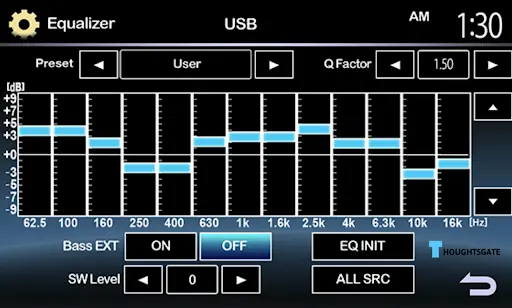
You can achieve deeper registers on string instruments like the electric guitar, piano, and others by increasing the dB at the upper end of the bottom bandwidth. Intensifying the dB inside the 200Hz region helps boost the volume of even bass-heavy elements like brass bands and vocalists.
Make sure to try out a variety of various options within this range. To minimize distortion, explore how much you modify each instrument.
By decreasing all spectrum settings greater than the bottom tones, you can make the bass substantially louder when using a parametric equalizer than artificially increasing it. This method reduces the likelihood of clipping, a form of sound distortion.
Any equipment or software equalizer should provide a clipping indication, and you can use it if you choose to enhance rather than reduce. The level of bass enhancement will decrease if its clipping indicator flashes.
Best equalizer settings for your household audio/visual theater.
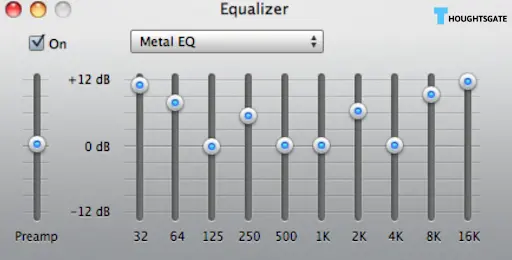
If you want a more enveloping listening pleasure, do it here by cranking up the volume. Seeing as how watching movies is usually the main reason why people set up a home theater.
Expecting a high-quality, fully immersing, enclosed performance when enjoying a film in your house cinema is reasonable. Worsening the experience by turning the bass up on equalization is not possible.
Therefore, harmony between the treble and rhythm section is sought. Most movie conversation is typically found in the mid-to high-range frequencies. Thus, optimizing these ranges is a good starting point. On the other hand, whether you’re viewing an adventure film, you might desire some serious bass.
Bass frequencies should be cranked up sparingly in the equalizer settings. For this reason, it’s preferable to maintain or decrease their level. The next step is to add a slight gain to the midrange tones, but not excessively, or you’ll get unwanted noise.
In addition, make sure the stereo sound is ideally adjusted; you desire a manageable amount of coming from any direction.
Perfect equalizer settings for gaming
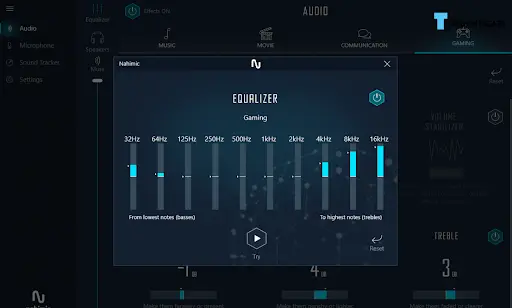
The games industry is now also significantly strongly influenced by audio. There are a lot of shooter games that rely considerably on listening closely, like the footfall of enemies. Also, to obtain a benefit over your competitors, you can equalize the audio so that you can hear them more clearly.
When finding the optimal settings for your gaming equalizer, I strongly recommend focusing on that audio quality. This will significantly assist you in determining the location of those footfalls.
Therefore, raise the frequencies of the midrange and high range without harming the shorter wavelengths. And with that, users should have enough information.
Best equalizer settings for music
The ideal Equalizer options of Acoustic music
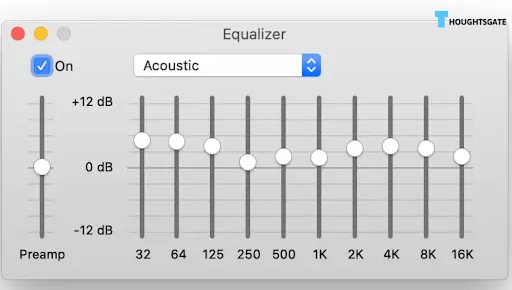
The equalizer setting is recommended if you favor acoustic renditions or prefer music without many basses or mechanically manipulated tunes.
To enhance the vocals of individuals and the sounds among many acoustic guitars without distorting them, you will be boosting only a touch of bass tones in addition to the medium and upper middle tones.
Equalizer options that work ideally for electronic music
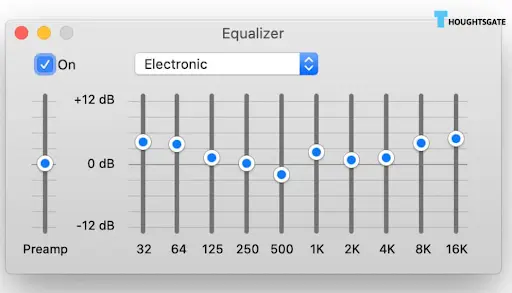
Because electronic music still shouldn’t typically emphasize vocals, it’s crucial to make the best use of digital tones in the higher frequency ranges. Due to this, you should try out a configuration similar to this and modify it according to your preferences.
Equalizer settings that work well for Latin music
The lyrics of Latin music are typically powerful enough that they do not need to be amplified any further than they already are because the music is so focused on low and high frequencies. Check out the following setup, and see if it fits your preferences:
The ideal EQ options for modern pop music
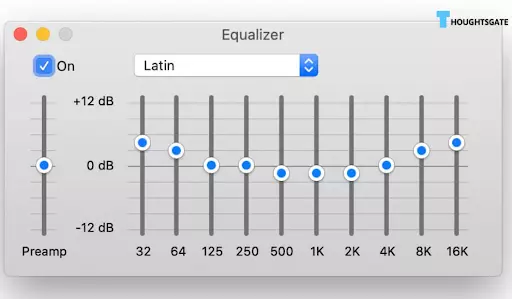
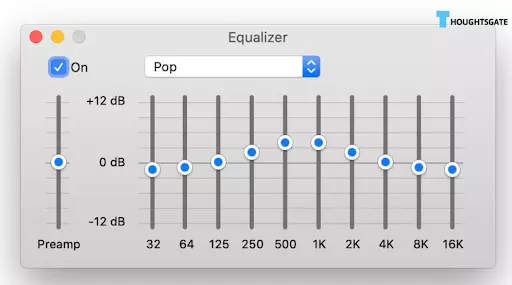
Genre Pop relies heavily on lyrics and mellow instrumentation. As seen in the figure, we plan to accentuate the semitones above all others while increasing the moderate and increased ranges slightly.
Best rock equalizer settings
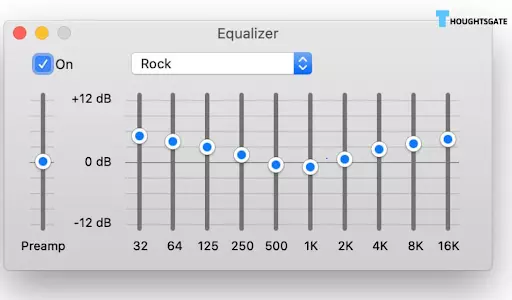
Rock is a popular musical style that emphasizes deep and upper-bandwidth sounds. If you’re looking to rock out to some tunes, try out these EQ options that boost everything but the midrange frequencies.
The perfect equalizer configuration for headphones.
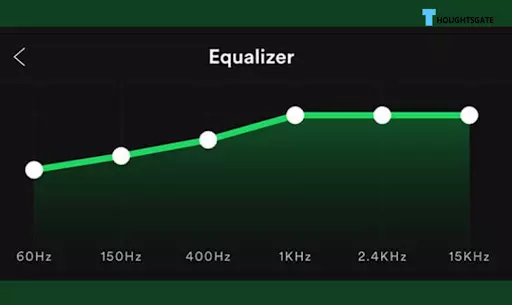
Many times throughout the day, you may require to tweak the headphones to get the best sound. Listening to songs on headphones is often your go-to activity. Moreover, various settings for equalization are essential for multiple musical genres.
Additional bass enhances the sound of some songs while greater clarity benefits tunes. Thus, we advise perfect music for a pleasant, undemanding audio sound quality. Whereas the rhythm section can remain unchanged, the sub-bass can be amplified.
You may rest assured that whatever song you play will sound great now. Afterward, you can tweak the wavelengths to your liking. In addition to these features, you may try out other genre-specific settings.
FAQs
What is the bass-friendly equalization setting?
There is no single answer to this question since it largely depends on personal preferences. Some people prefer a bass-heavy sound, while others prefer a more balanced one.
It also depends on the specific song or music being played – some songs may sound better with more bass, while others may sound better with less. Ultimately, it is up to the listener to experiment with different equalizer settings to find what sounds best to them.
What is the Spotify equalizer setting recommended?
The finest equalizer options for Spotify are already pre-installed and probably depend upon the music or audio you’re now playing to. The majority of online streaming services operate similarly. In addition, all you have to do to maximize the audio is select a musical genre.
What is the setting equalizer for best sound?
600 Hertz to 3,000 Hertz (Mids): the sweet spot for human hearing. In this frequency, you can hear the bulk of a person’s speech, making it ideal for experimenting with equalization levels to alter the tone of their voice. Higher Mids, or frequencies between 3,000 to 8,000 hertz, are typically treated with caution by audiophiles.
Which frequency produces the best bass?
Sub-bass frequencies are located in the bottom frequency range. Therefore that’s where you should focus your attention. Take, for example, the case of setting up the bass guitar for a performance. Perhaps you’re immersed in bass-heavy electronic dance music. Set the low end of your equalization between 50 and 100 hertz.
How can an EQ enhance the listening experience?
An equalizer, or EQ, is an audio analyzer that amplifies, decreases, or cancels individual frequencies. Numerous modern technological gadgets use equalizers. Among these are:
- Music players for the house
- Mobile audio systems
- Using apps optimized for use on various electronic devices
- Pedalboard or rack-mounted guitar impacts
- Boards used in recording studios for mixing
With an equalizer, you can change the tonal quality of a stream. Vocals may benefit from an increase in the high range, making them more transparent. Increased bass tones could give music a “heavier” feel.
FINAL WORDS
You can experiment with various options to improve the quality of your audio player’s performance. Begin with one of those defaults and adjust from there as needed.
You can instantly tell the improvement when you fine-tune your equalization by reproducing some music. As we’ve already established, everyone has different music preferences, so you can experiment by turning up or down different frequencies to find a sweet spot.
Remember that your speakers play a crucial role in this as well. To fully appreciate the benefits of an equalizer, you should listen with high-quality loudspeakers or, at the very least, invest in a nice set of headphones. A low-quality laptop’s built-in loudspeakers will distort if users attempt to amplify specific frequencies.
As you experiment with different equalization options and find the ones that listen ideal to your hearing system, you’ll be able to hear nuances in your soundtrack that you’ve never noticed before, deepening your appreciation for your tunes.

Benjamin is tech-savvy and loves to research the highly dynamic technological world. Keeping track of all the tech stocks, tech inventions, and latest developments in the tech world keeps him firm.
He has been writing for the past 12 years and is currently connected with ThoughtsGate.com. Playing ice hockey with his childhood friends is what keeps him fresh.
